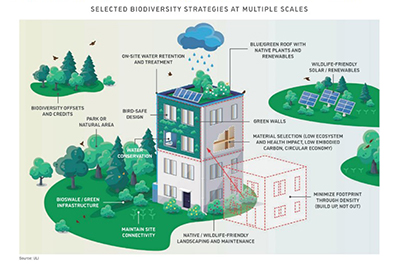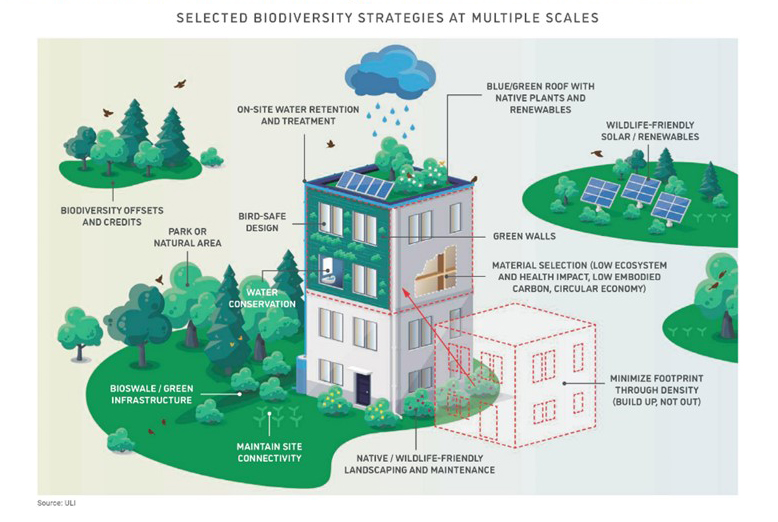
Report Highlights Importance of Prioritizing Biodiversity for Conserving Nature, Reducing Carbon Emissions

By taking steps to preserve biodiversity, real estate and land use professionals can protect critical natural resources, dramatically reduce carbon emissions, and enhance the value of their properties, according to a report from the Urban Land Institute.
“The loss of biodiversity, the degradation of natural resources, and the climate crisis are interconnected in many ways,” said Marta Schantz, co-executive director of ULI’s Randall Lewis Center for Sustainability in Real Estate. “Investing in nature creates strong returns on investment and can bring a range of benefits for businesses, employees, and communities alike. Practitioners in the real estate industry are increasingly recognizing this reality and taking steps to adapt and even reverse the loss of biodiversity.”

The report – Nature Positive and Net Zero: The Ecology of Real Estate –argues that the natural environment is the foundation of real estate value, community health and resilience, and provides a comprehensive framework for implementing real estate developments that deliver positive environmental, social, and financial returns.
Termed “nature-positive” solutions, these strategies seek to conserve or enhance biodiversity in site and building design and restore ecosystem health. Beyond the benefits for local wildlife, nature-based solutions are poised to provide up to 30% of the emissions reductions needed to reach net zero worldwide and are therefore a great investment for companies with net zero goals.
With the planet’s loss of biodiversity accelerating every day, reversing this trend is urgent for the health of the economy. According to the World Economic Forum, half of global GDP – $44 trillion of economic value – is reliant upon the natural environment.
The report offers five findings to help real estate developers implement nature-based solutions that can improve biodiversity:
–Understanding Real Estate’s Role: Real estate development is a primary driver of biodiversity loss by causing changes in land use that damage ecosystems, the report said. In addition, unsustainable sourcing of building materials and building-related emissions exacerbate the impact of climate change, which destroys natural habitats and results in species loss.
–Presenting the Business Case: Preserving biodiversity and natural ecosystems has a strong business case. It allows developers to get ahead of regulation, upgrade their property values, receive community buy-in for projects, and fulfill green building certifications.
–The Upside of Action: While nature-positive strategies directly improve biodiversity, they also offer numerous other benefits, including emissions reductions, improvements in energy efficiency, upgrades in air quality, and advancements in social equity.
–Current Models for Progress: Leading real estate developers and owners are already implementing nature-positive strategies in their businesses, such as creating native and pollinator-friendly landscapes, setting high standards for material procurement, and conserving water.
–Multi-Scale Development: Nature-positive development can happen at four scales of real estate: the portfolio level, building and site level, material selection level, and off-site level.
“The natural world offers us an endless source of inspiring and novel ways to reimagine how we solve pressing challenges to help our clients achieve next-level sustainability performance,” said Senior Vice President, Office of Global Climate Response & ESG Jan Walstrom. “As we continue to look toward the coming decades, we play a pivotal role in addressing the climate emergency. The planning, commitments, and response steps we take today are critical to leading the world to a more climate-resilient existence for all generations to come.”
